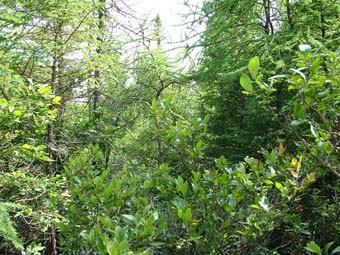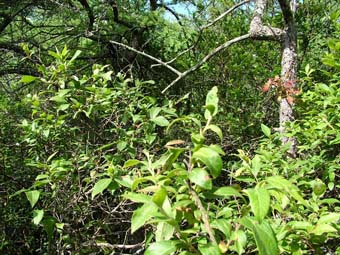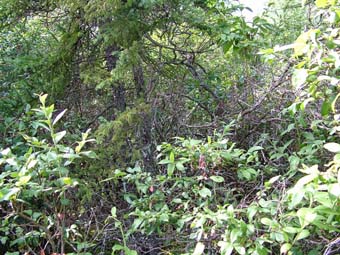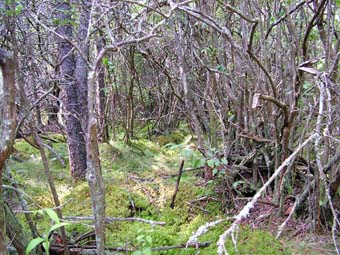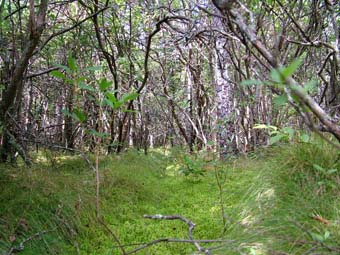Black Spruce – Tamarack Palustrine Woodland
System: Palustrine
Subsystem: Woodland
PA Ecological Group(s): Basin Wetland
Global Rank:G3G5
![]() rank interpretation
rank interpretation
State Rank: S2
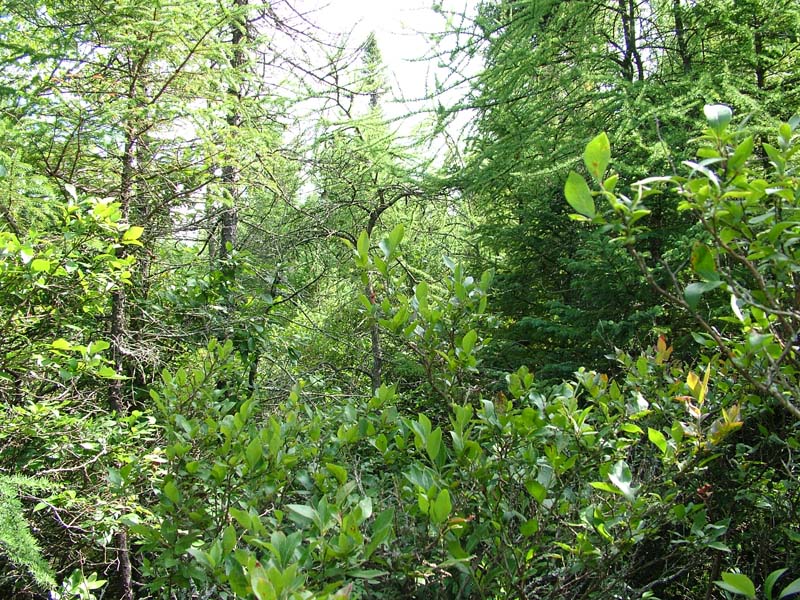
General Description
This describes a group of wetland woodlands found mostly in glacially formed, ice-block depressions (kettleholes) of small, higher-elevation watersheds of the glaciated regions of Pennsylvania and in cold-air pockets of drainages at higher elevations of the Unglaciated Allegheny Plateau. These wetlands are dominated by a mixture of black spruce (Picea mariana) and tamarack (Larix laricina). These are trees of short stature (<30 feet) growing as a sparse overstory (<40% cover). The substrate consists of deep, poorly decomposed peat. The woodland is often found interior (i.e., closer to the middle of the wetland) to the Black Spruce-Tamarack Peatland Forest and on the edge of the low-shrub bog. There is generally very little groundwater or surface water enrichment in these systems, resulting in nutrient stressed, stunted trees. Other trees that may occur include gray birch (Betula populifolia) and red maple (Acer rubrum). The sparse woodland gives way to tall black spruce and tamarack (Black Spruce – Tamarack Peatland Forest) away from the bog mat and this peatland forest gives way to a fringe of hemlock and other tall trees at the outer edge of the wetland where organic soils thin and become mineral. At this interface there is more nutrient input from surface and groundwater from the surrounding uplands.
The dominant shrub species is usually leatherleaf (Chamaedaphne calyculata), but may also include Labrador-tea (Rhododendron groenlandicum), bog-rosemary (Andromeda polifolia), swamp azalea (Rhododendron viscosum), mountain-holly (Ilex mucronata), winterberry (Ilex verticillata), and highbush blueberry (Vaccinium corymbosum) along with black chokeberry (Photinia melanocarpa), black huckleberry (Gaylussacia baccata) and sheep laurel (Kalmia angustifolia). The sedge, Carex trisperma, is often dominant along with a carpet of sphagnum mosses. Other species include star-flower (Trientalis borealis), white beak-rush (Rhynchospora alba), cinnamon fern (Osmunda cinnamomea), marsh fern (Thelypteris palustris), violets (Viola spp.), creeping snowberry (Gaultheria hispidula) and goldthread (Coptis trifolia). Sphagnum occurs throughout.
Rank Justification
Imperiled in the jurisdiction because of rarity due to very restricted range, very few populations, steep declines, or other factors making it very vulnerable to extirpation.
Identification
- Occurs on saturated soils in deep, peat-filled depressions with little inflow or outflow in small watersheds at high elevations in Pennsylvania (1000-2000 ft.)
- Conifers are dominant with only a few scattered broad-leaved deciduous trees, mostly red maple and gray birch
- Trees tend to be less than 30 feet tall and sparsely distributed (<40% cover)
- Often associated with an open bog-mat community dominated by leatherleaf, sedges, and sphagnum mosses
- Found between the low shrub bog and the surrounding wetland conifer forest
Shrubs
Herbs
- Sedge (Carex trisperma)
- Cinnamon fern (Osmunda cinnamomea)
- Pitcher-plant (Sarracenia purpurea)
- Spatulate-leaved sundew (Drosera intermedia)
- Round-leaved sundew (Drosera rotundifolia)
- Small cranberry (Vaccinium oxycoccos)
- Cranberry (Vaccinium macrocarpon)
- White beak-rush (Rhynchospora alba)
- Tawny cotton-grass (Eriophorum virginicum)
* limited to sites with higher soil calcium
Vascular plant nomenclature follows Rhoads and Block (2007). Bryophyte nomenclature follows Crum and Anderson (1981).
International Vegetation Classification Associations:
USNVC Crosswalk:None
Representative Community Types:
Black Spruce Woodland Bog (CEGL006098)
NatureServe Ecological Systems:
North-Central Interior and Appalachian Acidic Peatland (CES202.606)
NatureServe Group Level:
None
Origin of Concept
Fike, J. 1999. Terrestrial and palustrine plant communities of Pennsylvania. Pennsylvania Natural Diversity Inventory. Pennsylvania Department of Conservation and Recreation, Bureau of Forestry, Harrisburg, PA. 86 pp.
Pennsylvania Community Code*
WB : Black Spruce – Tamarack Palustrine Woodland
*(DCNR 1999, Stone 2006)
Similar Ecological Communities
Black Spruce – Tamarack Woodland is closely related to the Black Spruce – Tamarack Peatland Forest plant community type, which may occur adjacent to the woodland type. The distinction between the two is the percent canopy cover; the forested type typically has greater than 60% cover by trees, the woodland type is less than 60% cover.
Red Spruce Mixed Hardwood Palustrine Woodland and Black Spruce – Tamarack Woodland are similar in species composition but Red Spruce Mixed Hardwood Palustrine Woodland differs from this community type in that the Red Spruce Mixed Hardwood Palustrine Woodland is dominated by red spruce (Picea rubra).
Fike Crosswalk
Black Spruce – Tamarack Palustrine Woodland
Conservation Value
This is a rare plant community in Pennsylvania that has an unusual array of species and is habitat for both rare and common species of plants and animals that reside nowhere else in Pennsylvania including pitcher-plant (Sarracenia purpurea), sundews (Drosera spp.), and the white-throated sparrow (Zonotrichia albicollis). This community provides wintering habitat for northern bird species of spruce forests and woodlands that migrate south during severe winters. Some rare species found in this community include heartleaf twayblade (Listera cordata), dwarf mistletoe (Arceuthobium pusillum), Labrador-tea (Rhododendron groenlandicum), bog sedge (Carex paupercula), few-flowered sedge (Carex pauciflora), Collin’s sedge (Carex collinsii), few-seeded sedge (Carex oligosperma), blackpoll warbler (Dendroica striata), bog copper butterfly (Lycaena epixanthe), and snowshoe hare (Lepus americanus). This community can provide archaeological/historical data on past climates and species as the acidic conditions prevent breakdown of pollen and plant residue in peat.
Threats
Black Spruce – Tamarack Woodlands are threatened by habitat alteration in the small watersheds they occupy, nutrient input from surrounding uplands, and alterations to the hydrologic regime (beaver dams, lowering or raising of water tables). Clearing and development of adjacent land can lead to an accumulation of run-off, pollution, and sedimentation. As global climate change progresses, many boreal characteristic species within this community type may be intolerable of increasing temperatures. Invasive exotic plant species are not likely to be a threat unless there is nutrient input from surrounding uplands. Spruce budworm (Choristoneura fumiferana) and exotic invasive insects that feed on conifers may be a threat. Where disturbances are unavoidable, the wetland should be monitored for changes in vegetation, especially invasive species.
Management
In Pennsylvania, this community type is found in small watersheds on glacial deposits derived from sandstone and conglomerate as well as high-elevation wetlands of the Unglaciated Allegheny Plateau. These wetland communities depend on low availability of nutrients, minimal surface water and ground water inputs, and potentially cold temperatures. Development should be restricted to prevent alterations to the hydrologic and nutrient processes that drive this community.
A natural buffer around the wetland should be maintained in order to minimize nutrient runoff, pollution, and sedimentation. Since this community type is easily impacted by nutrient inputs, we would suggest a significant buffer between any logging operations or development and the wetland. Issues include the potential for soil erosion based on soil texture, condition of the adjacent vegetation (mature forests vs. early successional forests), and slope. As slope steepness increases the buffer should be extended. Impervious surfaces and compacted soils surrounding the wetland should be minimized to prevent surface runoff. Direct impacts and habitat alteration in the wetland should be avoided (e.g., roads, trails, filling of wetlands). Where impacts are necessary low-impact alternatives (e.g., elevated footpaths, boardwalks, bridges) are encouraged. Multiple high-quality examples of this type should come under conservation protection.
Research Needs
Variations may occur at eco-regional levels. There is a need to collect community plot data to characterize variations of this community to assist further classification. It is possible that this and other conifer wetland types were never logged. Knowing tree age and wetland history will provide information on the natural successional trajectory of this wetland as well as the vegetation and landscape of Pennsylvania prior to large-scale development. With potential global climate change, this community type is likely to be impacted. Occurrences of this community should be monitored for impacts such as changes in the health of the associated species and whether species composition shifts with the climate to determine if this community will persist in Pennsylvania.
Trends
The relative trend for this community is likely declining in the short term due to flooding from beaver activity. If natural succession is allowed to continue, many of these flooded occurrences will recover over time if potential global climate change does not prevent recovery.
Black Spruce – Tamarack Woodlands were probably more common in the northeast at one time but declined due to wetland draining for peat excavation, which was often followed by flooding for recreation. This type of alteration no longer occurs. Potential global climate change may be the biggest threat to this community type in Pennsylvania. Black spruce may also be under threat from spruce budworm and exotic pests.
Range Map
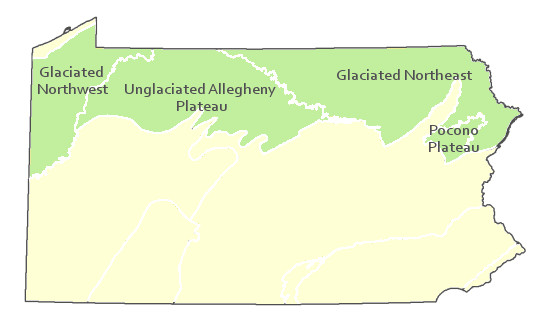
Pennsylvania Range
Glaciated Northeast, Glaciated Northwest, Pocono Plateau, Unglaciated Allegheny Plateau
Global Distribution
New Brunswick south to Pennsylvania and New Jersey
Cowardin, L.M., V. Carter, F.C. Golet, and E.T. La Roe. 1979. Classification of wetlands and deepwater habitats of the United States. U.S. Fish and Wildlife Service. Washington, D.C. 131 pp.
Edinger, Gregory J., D.J. Evans, Shane Gebauer, Timothy G. Howard, David M. Hunt, and Adele M. Olivero. 2002. Ecological Communities of New York State. Second Edition. A revised and expanded edition of Carol Reschke's Ecological Communities of New York State. New York Natural Heritage Program, New York State Department of Environmental Conservation. Albany, NY. 136 pp.
Fike, J. 1999. Terrestrial and palustrine plant communities of Pennsylvania. Pennsylvania Natural Diversity Inventory. Harrisburg, PA. 79 pp.
Johnson, C.W. 1985. Bogs of the Northeast. University Press of New England.
Larsen, J.A. 1982. Ecology of Northern Lowland Bogs and Conifer Forests. Academic Press, New York.
Merritt, J.F. 1987. Guide to the Mammals of Pennsylvania. University of Pittsburgh Press.
NatureServe. 2009. NatureServe Central Databases. Arlington, Virginia. USA
Pennsylvania Department of Conservation and Natural Resources (DCNR). 1999. Inventory Manual of Procedure. For the Fourth State Forest Management Plan. Pennsylvania Bureau of Forestry, Division of Forest Advisory Service. Harrisburg, PA. 51 ppg.
Rhoads, A.F. and T.A. Block. 2007. The Plants of Pennsylvania, 2nd ed. University of Pennsylvania Press.
Stone, B., D. Gustafson, and B. Jones. 2006 (revised). Manual of Procedure for State Game Land Cover Typing. Commonwealth of Pennsylvania Game Commission, Bureau of Wildlife Habitat Management, Forest Inventory and Analysis Section, Forestry Division. Harrisburg, PA. 79 ppg.
Thompson, E. 1996. Natural communities of Vermont uplands and wetland. Nongame and Natural Heritage Program, Department of Fish and Wildlife in cooperation with The Nature Conservancy, Vermont chapter.
Wenger, S. 1999. A Review of the Scientific Literature on Riparian Buffer Width, Extent and Vegetation. Office of Public Outreach, Institute of Ecology, Univ. of Georgia, Athens.
Cite as:
Davis T. 2022. Pennsylvania Natural Heritage Program. Black Spruce – Tamarack Palustrine Woodland Factsheet. Available from: https://www.naturalheritage.state.pa.us/Community.aspx?=16050 Date Accessed: January 13, 2026

